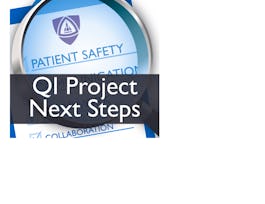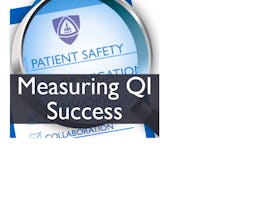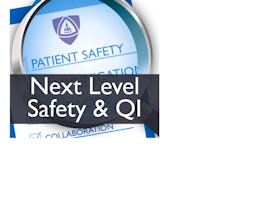Keeping patient safety and quality improvement projects on track, on time, and on budget is critical to ensuring their success. In this course, students will be introduced and given the opportunity to apply a series of tools to guide and manage patient safety and quality initiatives. These include tools for defining what success looks like, developing a change management plan, and conducting a pre-mortem to identify risks for project failure. This course will also provide tools for engaging stakeholders to ensure key players are invested in your project’s success.


Designing for Sustainment: Keeping Improvement Work on Track (Patient Safety IV)
This course is part of Patient Safety Specialization
Taught in English
Some content may not be translated

Instructor: Lisa H. Lubomski, PhD
4,437 already enrolled
Included with 
Course
(82 reviews)
What you'll learn
Recognize the importance of planning for project sustainment.
Use the pre-mortem exercise to identify risks of project failure.
Design a change management plan that addresses technical and adaptive challenges.
Describe the 4E’s + 2 Model and its use to engage stakeholders.
Skills you'll gain
Details to know

Add to your LinkedIn profile
3 quizzes
Course
(82 reviews)
See how employees at top companies are mastering in-demand skills

Build your subject-matter expertise
- Learn new concepts from industry experts
- Gain a foundational understanding of a subject or tool
- Develop job-relevant skills with hands-on projects
- Earn a shareable career certificate


Earn a career certificate
Add this credential to your LinkedIn profile, resume, or CV
Share it on social media and in your performance review

There are 4 modules in this course
In this module, learners will develop an understanding of what project sustainment is and why it is important, the potential risks to project sustainment, the importance of planning for sustainment from project inception, types of measures used in quality improvement projects and the attributes of each, how strategies for improvement were developed in two successful large-scale quality improvement initiatives. Learners will become familiar with the issues impacting sustainment and how they may be successfully addressed across the life span of a quality improvement project.
What's included
6 videos
In this module, learners will develop an understanding of what the Pre-Mortem exercise is and how it can be used to: improve project planning, surface threats to project success and sustainment, develop interventions to mitigate risk of project failure, create an action plan to maximize the application of Pre-Mortem results, and maintain awareness of threats to project success across the project lifespan. Learners will also develop familiarity with facilitation best-practices. The Pre-Mortem Exercise can be a powerful tool to identify and mitigate risks for project failure.
What's included
5 videos1 quiz
In this module, learners will develop an understanding of: what is meant by change management, reasons for change initiative failure, change as a process, frameworks and processes for change, the differences between technical and adaptive work and the role of each in a change effort, leadership skills necessary for addressing adaptive change, identifying and engaging change effort stakeholders, managing conflict, developing a communication strategy for a change effort, applying a systems approach to change efforts.
What's included
8 videos1 quiz
In this module, learners will develop an understanding of: the role of engagement in sustainability and spread, addressing barriers to engagement, potential areas of failure in sustaining change effort gains, the 2 E's of embedding and enduring and their role in sustainment, frameworks for sustaining change efforts, a real-world example of successful sustainment of a quality improvement initiative.
What's included
10 videos1 quiz1 peer review
Instructor

Offered by
Recommended if you're interested in Patient Care

Johns Hopkins University

Johns Hopkins University

Johns Hopkins University

Coursera Project Network
Why people choose Coursera for their career




Learner reviews
Showing 3 of 82
82 reviews
- 5 stars
75.60%
- 4 stars
17.07%
- 3 stars
2.43%
- 2 stars
2.43%
- 1 star
2.43%
New to Patient Care? Start here.

Open new doors with Coursera Plus
Unlimited access to 7,000+ world-class courses, hands-on projects, and job-ready certificate programs - all included in your subscription
Advance your career with an online degree
Earn a degree from world-class universities - 100% online
Join over 3,400 global companies that choose Coursera for Business
Upskill your employees to excel in the digital economy
Frequently asked questions
Access to lectures and assignments depends on your type of enrollment. If you take a course in audit mode, you will be able to see most course materials for free. To access graded assignments and to earn a Certificate, you will need to purchase the Certificate experience, during or after your audit. If you don't see the audit option:
The course may not offer an audit option. You can try a Free Trial instead, or apply for Financial Aid.
The course may offer 'Full Course, No Certificate' instead. This option lets you see all course materials, submit required assessments, and get a final grade. This also means that you will not be able to purchase a Certificate experience.
When you enroll in the course, you get access to all of the courses in the Specialization, and you earn a certificate when you complete the work. Your electronic Certificate will be added to your Accomplishments page - from there, you can print your Certificate or add it to your LinkedIn profile. If you only want to read and view the course content, you can audit the course for free.
If you subscribed, you get a 7-day free trial during which you can cancel at no penalty. After that, we don’t give refunds, but you can cancel your subscription at any time. See our full refund policy.

